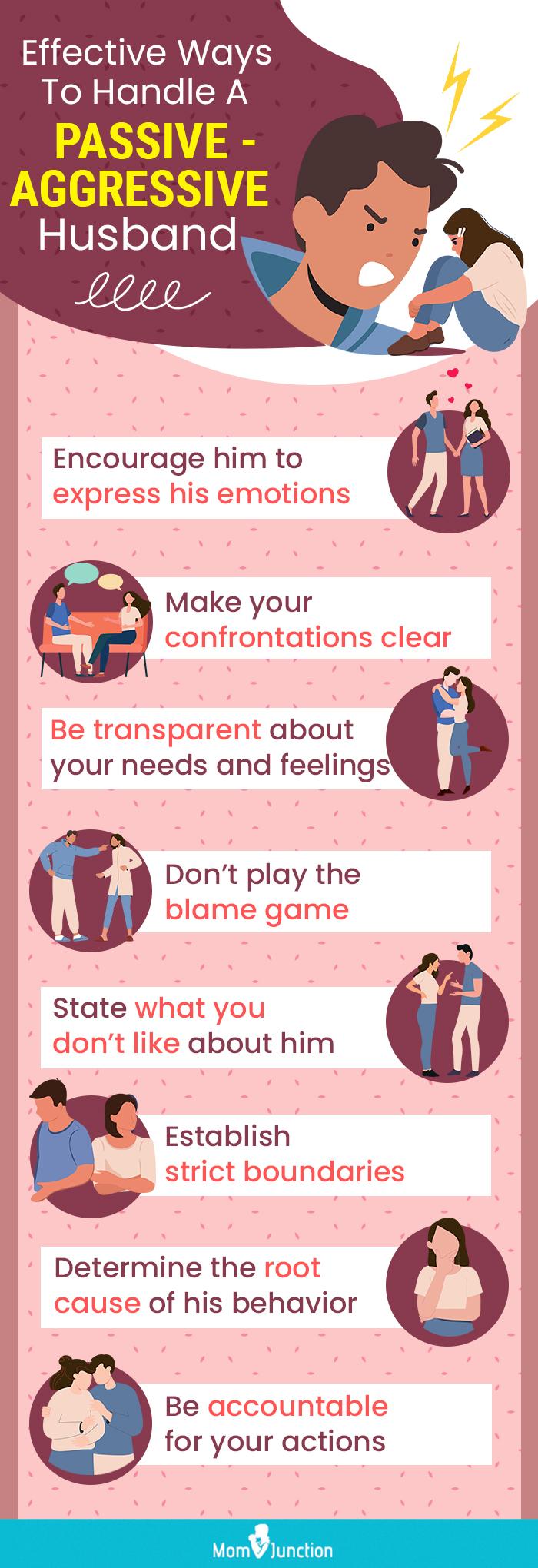
Image: Created with Dall.E
Passive aggressive behavior has a deep impact on your mental health. A passive aggressive husband can be manipulative and toxic for you. Your husband may not realize it, but the truth is that his behavior is critical in damaging the relationship that you both have built over the years.
Initially, it may take some time to understand how badly it affects you or the relationship, but soon you will reach a phase where you just can’t take it anymore. In this post, we discuss passive aggressive behavior and how to deal with it in detail. Read on to learn more.
What Is Passive Aggressiveness?
Passive-aggressiveness is a behavior where people tend to avoid direct conflict and express their anger indirectly through sulking, procrastination, withdrawal, stubbornness, controlling, and sabotaging tasks (1).
They are driven by the belief that displaying anger and being dismissive and hostile will show the other person they are hurt or enact a form of revenge. This behavior pattern gradually destroys the relationship.
On the outside, a PA person may seem friendly, polite, and kind but underneath they are hurt and feel disrespected. It is indirect and implicit and can be difficult to identify but not impossible. All you have to do is look for some signs.
Note: The signs, behavior and other information mentioned in this post are applicable to a passive-aggressive wife as well.
Signs of A Passive-aggressive Husband
A passive aggressive husband is passive on the outside and aggressive inside. Remember, these traits surface or the husband might behave this way if he is hurt with the behavior of the wife or her attitude but is unable to express it in any other way.
The behavior traits of a passive-aggressive husband are (2):
- Silent treatment:He is an expert at being silently revengeful. He becomes uncommunicative to punish you and prove that you are wrong. While you might break your head to make him utter a word, he is as hard as a rock buried in his shell. He might use words such as ‘fine’ or ‘whatever’ to shut off the communication.
- Vagueness: He says one thing and does something else and denies that he has said that at all. When you ask him to do something, he agrees but does not do it.
 Trivia
Trivia- Procrastination: He keeps postponing things because he doesn’t want to do them. Without directly refusing, he delays the tasks to the point that you get angry and when you yell at him, he blames you for being unreasonable and impatient. This could be an element of control
Image: IStock
- Sabotage: Deliberately failing at tasks can be used as a power play and to seek revenge. In severe cases, sabotaging is used to undermine your confidence and authority.
- Forgetting: Instead of saying ‘no’, he forgets the plans that were discussed, important events or errands. He expresses his anger by pretending to forget things.
- Sulking: A passive-aggressive person often does not express his emotions and hence resorts to sulking and other sullen behavior such as being moody, to get attention. Whenever he wants to get things done his way, he might sulk until the partner submits.
- Never angry: He may have grown up with the belief that it’s not acceptable to express anger, but the repressed anger is let out covertly through oppositional behavior like being resentful. Externally he might agree to do whatever you say but internally he is angry and he shows that in other ways.
- Plays the victim card: He shifts the blame on you because he thinks it is your fault and not his. He doesn’t take up responsibility and may deny that the problem lies with him. He may fail to see his own self-destructive behavioral patterns.
- Dependency: A passive-aggressive person fears dependency because of his non-assertive and indecisive nature. He doesn’t realize that he is dependent, but the fear of dependency is exhibited in the form of being emotionally distant and extremely private in his thoughts.
- Withhold: Withholding is a power game for passive-aggressive husbands. They withhold by stopping chores such as cleaning and cooking, and even love, affection, intimacy, and sex. This is their way to express anger and control.
Image: IStock
It’s frustrating and uncomfortable living with a passive-aggressive husband because it is next to impossible to figure out what makes him behave that way.
What Causes Passive-aggression?
Passive aggression is a learned behavior that can be traced to one’s childhood (3). Family dynamics can contribute to passive-aggressive behavior. The child copes with it by using defense mechanism to protect himself from the underlying feelings of rejection, fear, insecurity, mistrust, and low self-esteem. As they cannot express things openly they do it subtly by being passive-aggressive.
Let’s look at the causes of passive-aggressive behavior in detail (4):
- Belief that anger is unacceptable: In most cases, we tend to believe that expressing anger is not right and if we defy the rules, we will face negative consequences. Hence, we tend to suppress anger.
For example, if a child has been punished or scolded repeatedly for expressing his disinterest or feelings, then the child tends to believe that expressing his anger is not alright. So he conforms to the parents’ wishes to be ‘good’. When this pattern is repeated, the child succumbs to pressure and learns to suppress his anger and becomes adept at being passive-aggressive.
 Did you know?
Did you know?- ‘Covert’ anger: When the anger cannot be expressed openly, the person learns to express it covertly or in socially acceptable ways, that is by procrastinating, being vague and obstructive.
- It’s easier to be passive-aggressive than to be assertive: If the child is not taught to tap into his emotional intelligence and assertiveness, he grows up to be a person who cannot be assertive and honest. Passive-aggressive behavior such as sulking, withdrawal, and stubborn behavior can become a pattern in him.
- Rationalize their behavior: The person may try to rationalize by making himself believe that this behavior is fine, and holds the wife responsible for extracting such reaction from him. He blames her for setting high expectations and being unreasonable.
Image: IStock
- Getting back: The behavior pattern of a passive-aggressive person involves getting back at the other person. He might be angry, upset, or disappointed with something. But he cannot express it, so he finds an outlet to his emotions by being indifferent and defensive.
As a person at the receiving end, you would be frustrated with your husband’s reactions, and confused about your course of action.
How To Face A Passive-aggressive Husband?
When you discuss it, your husband might either deny it or blame you for that. Here’s what you can do (3):
- Try to help your husband talk about his emotions. His PA behavior might usually be a reaction to your assertiveness. In that case, model your assertiveness and emotional safety through healthy conflict that is successful.
- Be clear when confronting. Do not make generic statements such as, “you are always like this”. If there is something specific you don’t like, such as forgetting his tasks, then tell him about it.
Image: Shutterstock
- Be assertive. Your husband might not like you to be so. But you need to be assertive yet neutral and respectful in your communication. Consider your spouse’s feelings and opinions and be accommodative; aim at resolving the problem.
- Don’t blame or judge. Simply tell him what you don’t like about him. For example, “I don’t like when the TV is not put off before going to sleep, or I don’t like the yard to be left unclean after watering the plants.” Do not dig the past and rake up the bygone issues.
- Set boundaries. You need to have strict boundaries with consequences for a PA husband. For example, “I am not going to open the door if you drink and come home, or “I am not going to tolerate it if you mistreat me.” Set such boundaries that will make a difference to him lest he ignores those too.
Jennifer Brick, a YouTuber, author, and corporate trainer who addresses life and work issues, gives an easy way to shut down passive-aggressive people. She says that she has personally been using the question, ‘Are you trying to be helpful or hurtful?’ Brick shares, “I started using this with people several months ago, and there has not been an instance where I’ve used it where the person hasn’t backed off (i).”
- Understand the underlying reason for his behavior. Passive-aggressive people are not bad. It is just that they don’t know how to deal with their emotions and cannot express them. They assume that others understand their emotions, needs, and wants.
- Take responsibility for your behavior. There could be instances where your behavior could elicit a PA reaction from your spouse. So, understand the dynamics that are causing that and change your behavior.
A relationship with a passive-aggressive husband is challenging. You need to have a lot of patience and strength to deal with him.
How To Manage Passive–Aggressiveness In Your Husband?
You could be frustrated, angry, annoyed, and hurt by your husband’s attitude. But nothing can be achieved by being impulsive. So, put all your negative emotions on the back-burner and deal with him with a cool mind.
- Identify the warning signs: The greatest problem with a passive-aggressive husband is that the person at the receiving end becomes so emotionally overwhelmed and drained out that they are not aware of the problem. You can recognize the passive-aggressive patterns if you detach yourself from the conflict. Detachment helps you from being victimized. As we mentioned earlier, the typical passive-aggressive behavior patterns include:
a. Too many excuses
b. Deliberate inefficiency
c. Silent treatment
d. Closing conversations abruptly with ‘fine’ or ‘whatever’
e. They withhold things that are important
- Plan a strategy: Do not face him head-on or react immediately. Such a reaction will invite more negativity. Plan how to face him, how to talk to him and communicate your feelings to him. A soft approach will make things fine for you both because your action could have been the trigger for his reaction.
- Stay calm: It’s hard to remain calm when a person is driving you crazy with his behavior. But there is a reason to stay calm. He wants you to get angry at him so that he can put the blame on you. So, don’t give him the opportunity to do that. Keep your calm and ignore the behavior.
Image: IStock
- Make your requests clear and straight: If you give him generic instructions to carry on a task, he will definitely make it up as a misunderstanding. So, set clear expectations with specific timelines. Don’t assume that he will understand your needs even if it’s a routine task. Be assertive and neutral in your request. Don’t be sarcastic or arrogant.
Frequently Asked Questions
1. Are passive-aggressive men narcissists?
Individuals with a narcissistic personality disorder may covertly use passive-aggressive actions to convey their frustration or enhance their perceived superiority.
2. What zodiac signs are passive-aggressive?
Due to their personality traits, Cancer, Virgo, Pisces, and Libra may be more likely to engage in passive-aggressive conduct. However, astrology should not be used to draw generalizations about a person’s behavior because anyone can exhibit it regardless of their astrological sign.
3. Is passive-aggressive the same as gaslighting?
Passive-aggressive behavior can sometimes manifest in various forms, including gaslighting and emotional manipulation. However, some people may also use gaslighting to gain attention and control over their partners.
The behavior of a passive-aggressive husband may lead to the gradual destruction of the relationship. If you notice more of the above signs of passive aggression, discuss the issue with them. Perhaps, they do not know that they are exhibiting these signs, so help them by correcting their behavioral patterns. Be patient if they are putting in an effort. In the meantime, try to set healthy boundaries, accept your mistakes, and understand the purpose of this relationship. Although it is a challenging task that requires constant effort, trust, and patience, consistency can help ensure a stable relationship.
Infographic: How To Deal With A Passive-Aggressive Husband?
Being passive-aggressive might help avoid conflicts for a short period, but it is certainly not healthy to bolt up emotions. With time, it could lead to adverse situations for both spouses. If you think your husband is passive-aggressive, read the infographic below to learn ways to handle him. Illustration: Momjunction Design Team
Key Pointers
- A passive-aggressive husband can cause mental stress and damage the relationship.
- Signs of passive-aggressiveness include the silent treatment, vagueness, procrastination, sabotage, sulking, and playing the victim card.
- Passive-aggressiveness can stem from an inability to express anger, rationalizing one’s behavior, or seeking revenge.
- Facing passive-aggressive behavior involves being assertive, setting boundaries, understanding the cause, and identifying triggers.
Watch this video to learn about the traits and behaviors of passive-aggressive narcissists and how to manage them
Personal Experience: Source
MomJunction articles include first-hand experiences to provide you with better insights through real-life narratives. Here are the sources of personal accounts referenced in this article.
i. Shut down passive aggressive people at work instantly.https://www.youtube.com/shorts/XcKqOChSFPc?feature=share
References
- Managing passive-aggressive behavior.
https://www.cascadehealth.org/wp-content/uploads/2017/01/Passive-Aggressive-Behavior.pdf - 8 clear signs of passive aggressive behavior.
https://theprivatetherapyclinic.co.uk/blog/8-signs-of-passive-aggressive-behaviour/ - How to stop passive aggression from ruining your relationship.
https://greatergood.berkeley.edu/article/item/how_to_stop_passive_aggression_from_ruining_your_relationship - Working with passive aggressive behavior when developing trusting relationships.
https://www.simplypsychology.org/passive-aggressive-behavior.html#Causes - What Is Passive-Aggressive Behavior?
https://www.simplypsychology.org/passive-aggressive-behavior.html
























